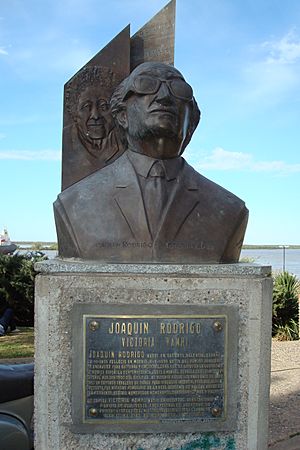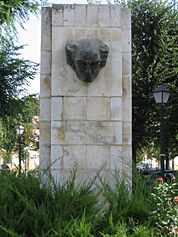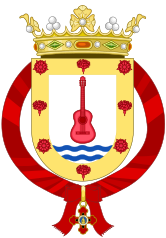Joaquín Rodrigo facts for kids
Quick facts for kids
The Most Illustrious
Joaquín Rodrigo
|
|
|---|---|

Monument in Rosario, Argentina
|
|
| Born | 22 November 1901 |
| Died | 6 July 1999 (aged 97) Madrid, Spain
|
| Nationality | Spanish |
| Spouse(s) | Victoria Kamhi |
Joaquín Rodrigo Vidre, 1st Marquess of the Gardens of Aranjuez (born November 22, 1901 – died July 6, 1999), was a famous Spanish composer. He was also a very skilled pianist, known as a virtuoso. He is most famous for writing the Concierto de Aranjuez. This piece is a very important part of music for the classical guitar.
Contents
Life Story of Joaquín Rodrigo
Joaquín Rodrigo was born in Sagunto in Spain. When he was three years old, he became completely blind because of an illness called diphtheria. Even though he couldn't see, he started learning music at a young age. He began studying piano and violin when he was eight. By the time he was 16, he was learning about harmony and how to compose music.
How He Composed Music
Rodrigo became famous for making the Spanish guitar a respected instrument for concerts. But he never actually learned to play the guitar himself! He wrote all his music using Braille, which is a system of raised dots for blind people. Then, his music was written down for others to read and play.
He studied music in Valencia and later in Paris with famous teachers like Paul Dukas. He also studied musicology, which is the study of music history and theory. In 1947, Rodrigo became a professor of music history at the Complutense University of Madrid.
His Most Famous Work: Concierto de Aranjuez
Rodrigo's most well-known piece is the Concierto de Aranjuez. He wrote it in 1939 in Paris for a guitarist named Regino Sainz de la Maza. Later in life, he and his wife said that this piece was written after they lost their first child. It was a very personal piece of music for them.
A concerto is a piece of music for a solo instrument and an orchestra. The Concierto de Aranjuez is for guitar and orchestra. The middle part, called the Adagio, is very famous. You might recognize its beautiful melody. This part features the guitar playing with another instrument called the cor anglais. A jazz musician named Gil Evans even adapted this movement for Miles Davis's album "Sketches of Spain". Rodrigo also made a version of this concerto for harp and orchestra.
Other Important Compositions
Because the Concierto de Aranjuez was so popular, many other musicians asked Rodrigo to write music for them. He wrote the Concierto serenata for harp and orchestra for Nicanor Zabaleta. He also wrote a cello concerto, Concierto como un divertimento, for Julian Lloyd Webber. For James Galway, he composed the Concierto pastoral for flute.
In 1954, Rodrigo wrote Fantasía para un gentilhombre for the famous guitarist Andrés Segovia. He also wrote Concierto Andaluz for four guitars and orchestra. While he wrote many great pieces, the Concierto de Aranjuez and the Fantasia para un gentilhombre are his most loved works.
Awards and Honors
Joaquín Rodrigo received many important awards during his life. In 1983, he won Spain's highest award for music, the Premio Nacional de Música.
In 1991, King Juan Carlos I of Spain gave him a special title. He became the Marqués de los Jardines de Aranjuez, which means Marquess of the Gardens of Aranjuez. This was a very high honor. In 1996, he received the prestigious Prince of Asturias Awards, which is Spain's highest award for civilians. The French government also honored him in 1998.
Family Life
Joaquín Rodrigo married Victoria Kamhi, a pianist from Turkey, in 1933. Their daughter, Cecilia, was born in 1941. Rodrigo passed away in 1999 in Madrid when he was 97 years old. His daughter Cecilia inherited his title and became the Marquesa. Joaquín Rodrigo and his wife Victoria are buried in the cemetery at Aranjuez.
Types of Music He Wrote
Joaquín Rodrigo composed many different kinds of music. He wrote pieces for full orchestras, concertos for solo instruments with orchestras, and music for single instruments. He also wrote vocal and choral music.
Orchestral Music
Rodrigo wrote several pieces just for orchestra. These include:
- Juglares (1923)
- Cinco Piezas Infantiles (1928), which means "Five Children's Pieces"
- Zarabanda lejana y Villancico (1930)
- A la busca del más allá (1976), which was inspired by space exploration.
He also wrote music for symphonic wind ensembles, which are like orchestras but mainly use wind instruments.
Concertos for Solo Instruments
Rodrigo was famous for his concertos. These are pieces where one instrument plays a solo part with an orchestra.
- Cello Concertos: He wrote Concierto en modo galante (1949) and Concierto como un divertimento (1981) for the cello.
- Flute Concertos: He composed Concierto pastoral (1978) for the flute.
- Guitar Concertos: Besides the famous Concierto de Aranjuez, he wrote:
- Fantasía para un gentilhombre (1954)
- Concierto madrigal (1966) for two guitars
- Concierto Andaluz (1967) for four guitars
- Harp Concertos: He wrote Concierto serenata (1954) for the harp.
- Piano Concertos: He composed Concierto heroico (1943) for the piano.
- Violin Concertos: He wrote Concierto de estío (1944) for the violin.
Instrumental Music
Rodrigo also wrote many pieces for instruments playing alone or in small groups.
- Guitar Music: He wrote many solo pieces for guitar, including:
- Zarabanda lejana (1926)
- En Los Trigales (1938)
- Invocación y danza (1961)
- Elogio de la guitarra (1971)
- Piano Music: He wrote many pieces for solo piano, such as:
- Suite pour piano (1923)
- Cuatro Piezas (1936–1938)
- El Album de Cecilia (1948), a collection of pieces for his daughter.
He also wrote music for two pianos or piano duets.
Vocal and Choral Music
Rodrigo composed music for voices, both for solo singers and for choirs.
- Ave Maria for choir (1923)
- Cuatro Madrigales Amatorios (1948)
- Villancicos y canciones de navidad (1952), which are Christmas carols.
- He also wrote songs for guitar and voice, like Coplas del Pastor Enamorado (1935).
See also
 In Spanish: Joaquín Rodrigo para niños
In Spanish: Joaquín Rodrigo para niños



